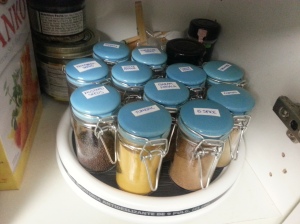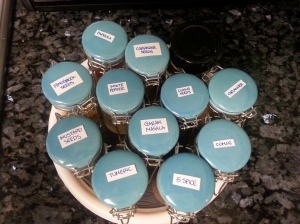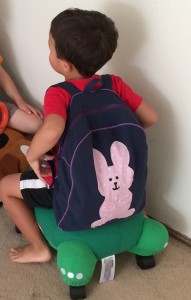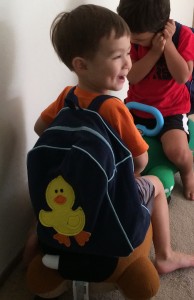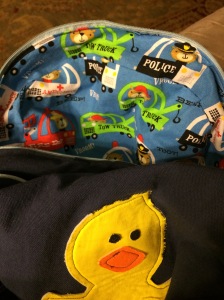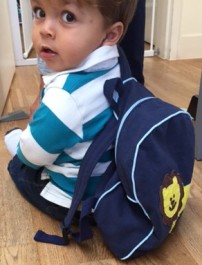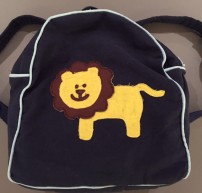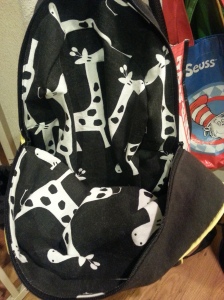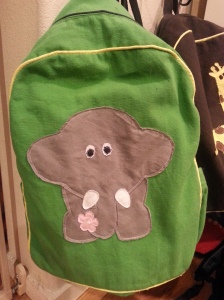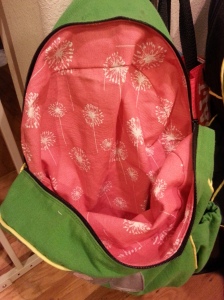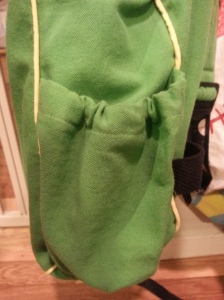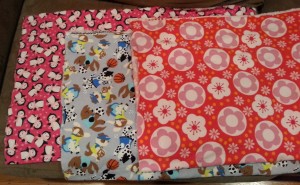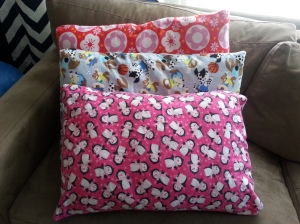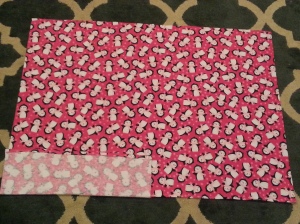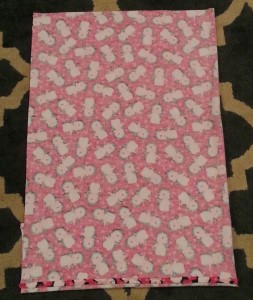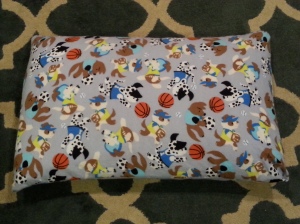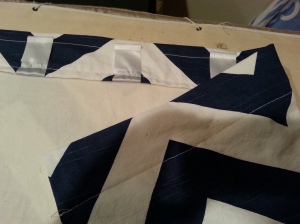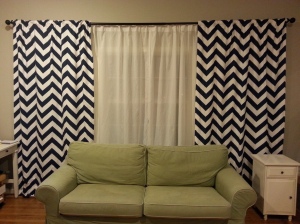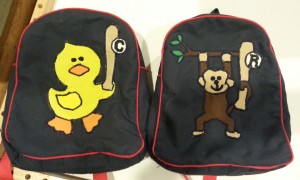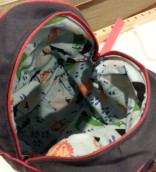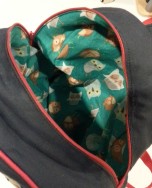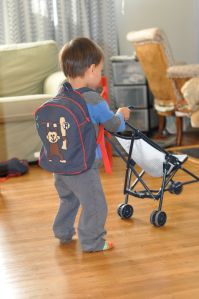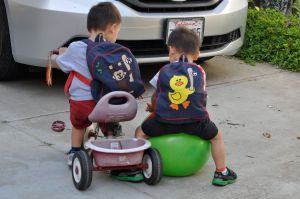I’ll admit that I’ve been wanting to tackle a chair upholstery project for a while, but didn’t really want to spend money on a chair when I wasn’t sure if it would turn out well. (That is pretty much my MO when it comes to upholstery!) I actually almost bought a wingback recliner for $40, but got cold feet. So, imagine how excited I was to get two armchairs for free from someone on Craigslist. It looks like they gave up on the same upholstering project I was about to undertake.
BEFORE:
It doesn’t actually look too bad in this photo, but the fabric wasn’t securely attached anywhere and the upholstery tacks were also loose.

Under that was this gorgeous fabric that I think a professional “installed”.
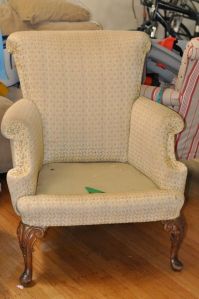
And under that was the original fabulous floral fabric. Who knows how long that’s been there?!
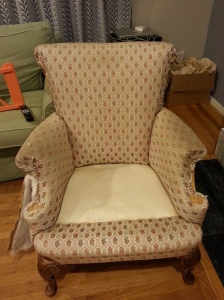
AFTER:
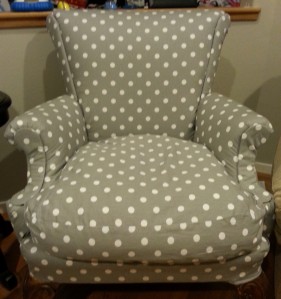
There are lots of great how to’s online, including this one and this one, but I couldn’t find any that really explained how to do the seat deck (the part under the cushion) that attaches to the lip (material in front on the bottom), so I found this posting to be helpful in understanding and visualizing what I was working with.
The general consensus on the internet is that upholstery isn’t particularly hard, but takes a ton of time and patience. The general attack plan, taking pictures all the while, is take the chair apart, keep and label all the pieces, use them as patterns, reassemble in the reverse order. Many people say an electric staple gun is really helpful, but I didn’t mind using my manual one.
My chairs had 3 layers of fabric and I think that a professional upholstered the chair before the person I got it from because it seemed like that material was attached between wood, indicating the whole chair had been taken apart, not just the fabric being removed. I decided that I would just remove 2 layers and leave the original floral fabric.
Materials (for each chair)
- 3 1/2 to 4 yards of fabric – I think I would have made it with 3 1/2, but I got 4 to be safe.
- Tack remover
- Staple gun
- Upholstery staples – size dependent on your chair
- 1 1/2 yards of Pli-Grip (I didn’t use all 1 1/2 yards. You don’t need this if your existing pieces are reusable.)
- Hot glue gun and glue
Step 1: Deconstruction
I took a million pictures while deconstructing the chair to increase the chance I’d be able to put it back together. Here are some to give you an idea of how tedious it was. I think it took 6-8 hours.



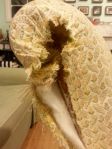
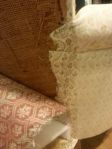

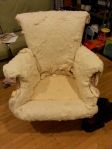


I labeled the fabric pieces as I went so that I could use them as pattern pieces and also kept a running list of what I took off in order so that I could reverse it when it came time to reassemble. Here’s the list for reassembly:
- Seat Deck (requires sewing)
- Inside Arms
- Front Back
- Outside Arms
- Back Back
- Front of arms (4 pieces)
- Underchair fabric
- Cushion cover (requires sewing)
I purchased this tack remover, which is optional, but for $2.40 ($3.99 with 40% off), it’s not really optional at all. I was surprised that very few sites I looked at re DIY upholstery mentioned this tool or anything like it. This saved me hours and hours and a lot of emotional stress.
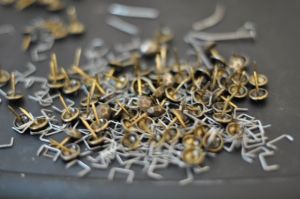
These were some areas that made me nervous about reconstructing:
- The arm parts had this weird metal thing sticking out and I wasn’t sure how it worked. (I ended up hammering it down and not using it.)
- The parts with tacks looked like medieval torture devices and some of the metal tines got stuck in the chair, so I thought I might have to replace them. (I was able to reuse some and replace some with pli-grip.)
- The layered cardboard that attaches to the arm areas was cracked and I didn’t know where to get a replacement. (I got chipboard from an art store. It worked great.)
The lesson here is don’t be scared. You’ll figure it out. Also, if you get stuck, there is this amazingly generous guy in Cape Cod who is a profession upholsterer who answers questions!
Step 2: Reconstruction
I wanted to reassemble the chair as soon as I could so I wouldn’t forget how it all went together. Also, it seemed that after taking it apart, putting it together would be much faster, more fun, and more satisfying. It’s kind of like moving. Packing all your stuff up sucks, but it’s pretty fun to unpack and find new places for everything in your new house. Though I had the best of intentions, this project dragged on for a while. I did the first chair and wasn’t that thrilled with the navy blue fabric I picked. So then it took me a while to pick a new fabric and get started on the 2nd chair. The good news is that the 2nd chair was way faster because I knew what I was doing. I feel really to tackle that wingback recliner now! (Sorry T :P)
Make sure you move the batting so you can pull the fabric through and staple it to the wood frame. Use new batting if necessary to provide a smooth base under the fabric. It was easy enough to get the main pieces down, but the front arm areas were challenging because I wasn’t planning on using nailhead trim to cover up my staples, so I had to be very careful about staple placement.
When it came to the original metal tines, I tried it and it seemed tight enough even with a couple missing pieces. There were some that didn’t have enough tines left, so I used Pli-Grip (google it for instructions). I didn’t love it because it was hard to staple properly, but it did the trick.
I ended up using chipboard instead of the original front arm cardboard. I cut two pieces of the same shape in a thinner and thicker piece of chipboard. I put nails through the thin piece, then glued the thicker piece on top with hot glue. Then I glue the fabric over that. You can also use staples if your use shorter staples, but I didn’t want to buy a whole package of staples just for this. The hot glue worked great. Then I carefully hammered the nails into the chair. The thicker chipboard kept the nails from poking through the fabric. You can also use some hot glue to help hold the edges in place.
Here are some pictures of the navy chair (1st one) and then one of the gray polka dot chair (2nd one), which is way cuter. I might redo the navy one so that they match because apparently I like to makeover my furniture twice (evidence)!
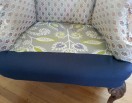



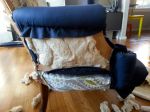
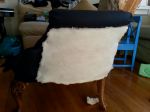
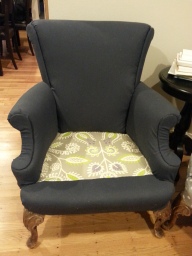
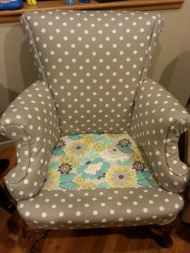
Step 3: Seat Cushion
The seat cushions are filled with down, which I was super stoked about. I washed them in my washing machine before sewing the cover them because who doesn’t love clean, fluffy down? The cushions are soooooooooooooooooooo luxuriously comfortable. I love them!
Whoever tackled this project before me gave up before finishing the cushion cover, so I didn’t have a perfect guide, but I improvised by looking at the general shape of the inside cover holding the down in. There were 3 pieces: top, bottom, 1 side piece. I traced half of the top piece to made a paper pattern so that both sides would be symmetrical as I flipped it over. I also added a long zipper to make the cover removable for cleaning, which turned out to be a great idea as one of my kids smashed raspberries in it the day after I finished!

(The cushion looks a little too big in this picture, but that’s just because it was a bit smooshed from being sat on. When fluffed, it fits perfectly.)
Budget (per chair)
- Fabric (Premier Prints Polka Dots Twill Storm) – $24
- Tack remover – $2.40 (40% off $3.99)
- Upholstery staples – $3.50
- Pli-Grip – $3.70
- Zipper – $3
- Staple gun, thread, hot glue gun, glue – I had these already.
TOTAL: less than $40!
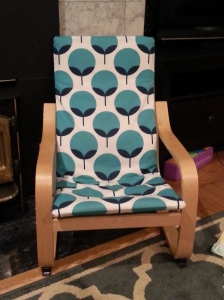



 Posted by Ruminating&Reflecting
Posted by Ruminating&Reflecting 